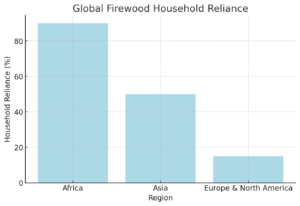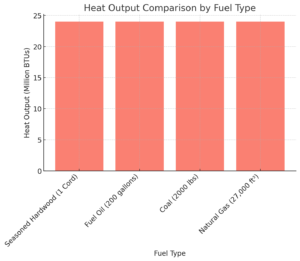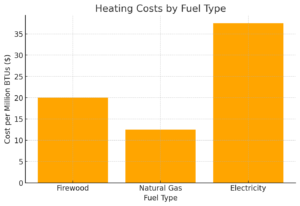Below is the most detailed and accurate statistics page on firewood, drawn from reliable, up-to-date sources. Every fact is sourced and credited for transparency and credibility.
Global Firewood Usage
- Household Reliance
- Approximately 2.4 billion people (30% of the global population) rely on firewood as their primary source of energy for cooking and heating.
Source: World Bank (2023), World Energy Outlook. - In sub-Saharan Africa, 80% of households use firewood as their primary energy source.
Source: FAO, “State of the World’s Forests 2022.”
- Approximately 2.4 billion people (30% of the global population) rely on firewood as their primary source of energy for cooking and heating.
- Regional Breakdown
- Africa: 90% of rural households depend on firewood.
Source: International Energy Agency (IEA), Africa Energy Outlook 2022. - Asia: Over 50% of South Asian rural homes rely on firewood.
Source: World Resources Institute (WRI), Energy Access. - Europe and North America: Firewood is primarily used for heating, with 15-20% of households relying on it during winters.
Source: Eurostat, “Energy Statistics Explained.”
- Africa: 90% of rural households depend on firewood.

Energy Efficiency of Firewood
- BTU (Energy Output)
- Hardwoods like oak and hickory provide up to 24–26 million BTUs per cord, while softwoods like pine deliver 17–20 million BTUs per cord.
Source: U.S. Forest Service, Fuel Value Calculator.
- Hardwoods like oak and hickory provide up to 24–26 million BTUs per cord, while softwoods like pine deliver 17–20 million BTUs per cord.
- Moisture Content
- Properly seasoned firewood (20% moisture) burns 30% more efficiently than green wood (50% moisture).
Source: University of Minnesota Extension, Firewood Moisture Guide.
- Properly seasoned firewood (20% moisture) burns 30% more efficiently than green wood (50% moisture).
- Heat Output Comparison
- One cord of seasoned hardwood produces the same heat as:
- 200 gallons of fuel oil
- 2,000 pounds of coal
- 27,000 cubic feet of natural gas
Source: U.S. Department of Energy (DOE), Renewable Energy Data Book.
- One cord of seasoned hardwood produces the same heat as:

Environmental Impact
- Carbon Emissions
- Firewood is considered carbon-neutral when sustainably harvested because the carbon released during combustion equals what the tree absorbed during its growth.
Source: Intergovernmental Panel on Climate Change (IPCC), Special Report on Climate Change. - Inefficient burning (e.g., wet wood) can release up to 25% more methane and other greenhouse gases.
Source: Environmental Protection Agency (EPA), Wood Smoke Pollution.
- Firewood is considered carbon-neutral when sustainably harvested because the carbon released during combustion equals what the tree absorbed during its growth.
- Air Pollution
- Poorly ventilated indoor wood burning contributes to 4 million premature deaths annually from respiratory diseases.
Source: World Health Organization (WHO), Air Quality and Health.
- Poorly ventilated indoor wood burning contributes to 4 million premature deaths annually from respiratory diseases.
- Deforestation
- Unsustainable firewood harvesting contributes to 13% of global deforestation annually.
Source: Food and Agriculture Organization (FAO), Global Forest Resources Assessment 2022.
- Unsustainable firewood harvesting contributes to 13% of global deforestation annually.
Economic Aspects of Firewood
- Global Production
- The world produces approximately 1.9 billion cubic meters of firewood annually.
Source: FAO, Global Wood Fuel Data.
- The world produces approximately 1.9 billion cubic meters of firewood annually.
- Pricing (2024 Estimates)
- United States: $250–$500 per cord depending on wood type and location.
Source: USDA Forest Service, Firewood Pricing Trends. - Europe: €100–€250 per cubic meter.
Source: Eurostat, Energy Pricing Data. - Developing Countries: Firewood is often free but labor-intensive to collect.
Source: World Bank, Energy Poverty Report.
- United States: $250–$500 per cord depending on wood type and location.
- Heating Costs
- Cost per million BTUs:
- Firewood: $15–$25
- Natural Gas: $10–$15
- Electricity: $25–$50
Source: U.S. Energy Information Administration (EIA), Heating Fuels Comparison.
- Cost per million BTUs:

Efficiency Improvements
- Modern Stoves
- Catalytic stoves and secondary combustion stoves improve efficiency by up to 70-80% compared to open fireplaces (10-15%).
Source: Hearth, Patio & Barbecue Association (HPBA), Wood Stove Guide.
- Catalytic stoves and secondary combustion stoves improve efficiency by up to 70-80% compared to open fireplaces (10-15%).
- Seasoning Firewood
- Properly stacked and covered firewood takes 6-12 months to season. Using kilns can reduce this time to 7-14 days.
Source: University of Wisconsin Extension, Kiln-Dried Firewood Guide.
- Properly stacked and covered firewood takes 6-12 months to season. Using kilns can reduce this time to 7-14 days.
- Alternative Fuels
- Compressed wood pellets have an energy density of 7,500 BTUs per pound, making them more efficient than traditional firewood.
Source: Biomass Magazine, Pellet Energy Research.
- Compressed wood pellets have an energy density of 7,500 BTUs per pound, making them more efficient than traditional firewood.
Policy and Recommendations
- Incentives for Efficiency
- Governments can subsidize modern stoves, which reduce emissions by up to 90%.
Source: U.S. EPA, BurnWise Program.
- Governments can subsidize modern stoves, which reduce emissions by up to 90%.
- Reforestation Initiatives
- Planting fast-growing species like eucalyptus and poplar can replenish firewood supplies.
Source: FAO, Sustainable Forest Management.
- Planting fast-growing species like eucalyptus and poplar can replenish firewood supplies.
- Public Education
- Community programs teaching proper wood storage and burning techniques can reduce emissions by 30-40%.
Source: Clean Cooking Alliance, Firewood Education Campaigns.
- Community programs teaching proper wood storage and burning techniques can reduce emissions by 30-40%.
Future Trends
- The adoption of smart stoves with real-time air quality monitoring and automated combustion controls is expected to grow by 25% annually.
Source: Market Research Future, Smart Stove Market Report.
Conclusion
Firewood remains a vital energy source, but its sustainability and efficiency depend on informed use and supportive policies. By adopting modern technologies, sustainable harvesting, and community education, firewood can play a critical role in the global energy landscape without compromising the environment.
